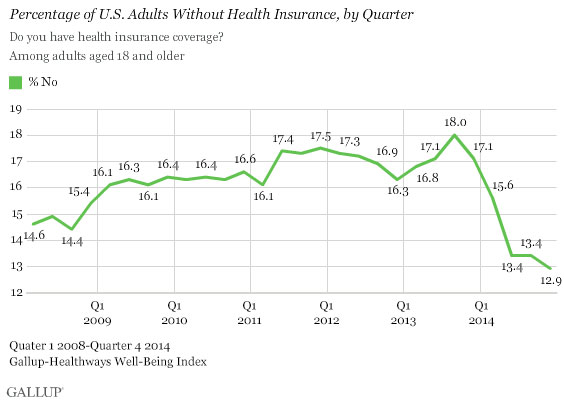One important clarification re. today's Gallup poll...
Gallup has released a big new health insurance survey this morning which is making a bunch of headlines, mainly focusing on the fact that 2 red states (Arkansas & Kentucky) saw the largest drop in uninsured rates last year. This is excellent and ironic news, of course.
However, the actual percentage drop nationally noted in the survey caught my eye. According to Gallup:
Nationwide, the uninsured rate dropped 3.5 percentage points last year, from 17.3% to 13.8%, the lowest annualized rate across the seven years of Well-Being Index measurement. No state reported a statistically significant increase in the percentage of uninsured in 2014 compared with 2013.
Again, this is very good news, but look closer: 17.3% > 13.8% is a reduction of just 20.2%. This is completely out of line with every one of Gallups' other health insurance surveys done over the past year, as well as similar surveys by the Urban Institute, Commonwealth Fund, RAND Corporation and so on. All of these showed a drop of anywhere from 25-30% by the end of last year. In addition, just last month Gallup released a poll showing the starting uninsured rate as being 18.0%, not 17.3%. What's going on here?
Simple: Look at the time window of today's survey:
Results are based on telephone interviews conducted Jan. 2-Dec. 30, 2013, and Jan. 2-Dec. 30, 2014, as part of the Gallup-Healthways Well-Being Index, with a random sample of 178,072 adults in 2013 and 176,702 adults in 2014, aged 18 and older, living in all 50 U.S. states and the District of Columbia.
In other words, they surveyed a mountain of people, but the polling was spread out over the full course of each year. These are full-year averages. There's nothing wrong with this, and 10 years from now it will be more practical to look at historical data from a year-to-year perspective. At the moment, however, things are changing very rapidly as enrollments/expansion/policy implementation goes into effect, and a month-to-month or quarter-to-quarter perspective is far more telling.
To illustrate this, let's look at Gallup's last quarterly poll, released just last month:

As you can see, 2013 started with an uninsured rate of 16.8%, but this shot up to 18.0% just before the first ACA open enrollment period started. By the end of 2014, the uninsured rate had plummeted to just 12.9%. If you average out all 4 quarters for each year, you get a less impressive-looking drop from 17.25% to 13.82%.
For example, take a look at yesterday's Medicaid report: Another 547,000 people were added to the Medicaid/CHIP roles in December alone. Assuming about 60% of those were previously uninsured, that's 0.1% all by itself...but diluted across the full year it gets lost in the shuffle.
As an aside, Andrew Sprung made another important observation about Gallup misinterpreting their own results in this survey, regarding the effectiveness of the state-based exchanges vs. Healthcare.Gov.



